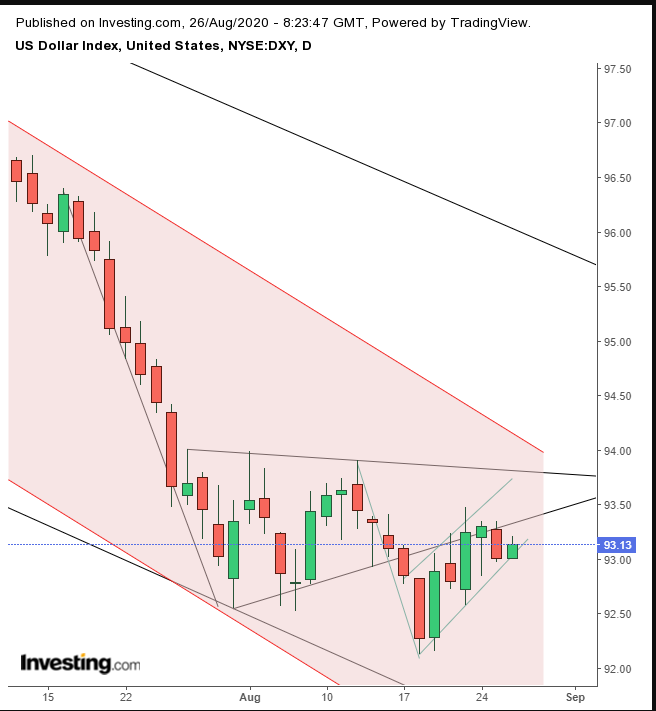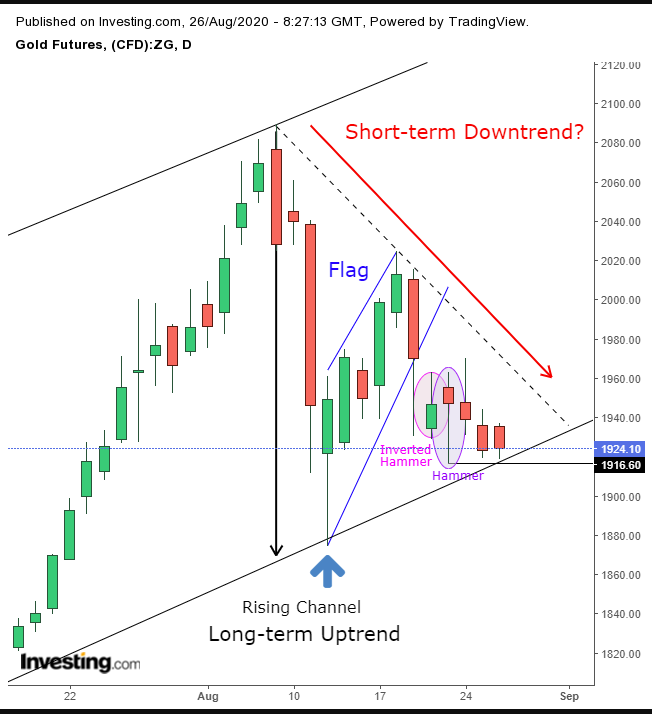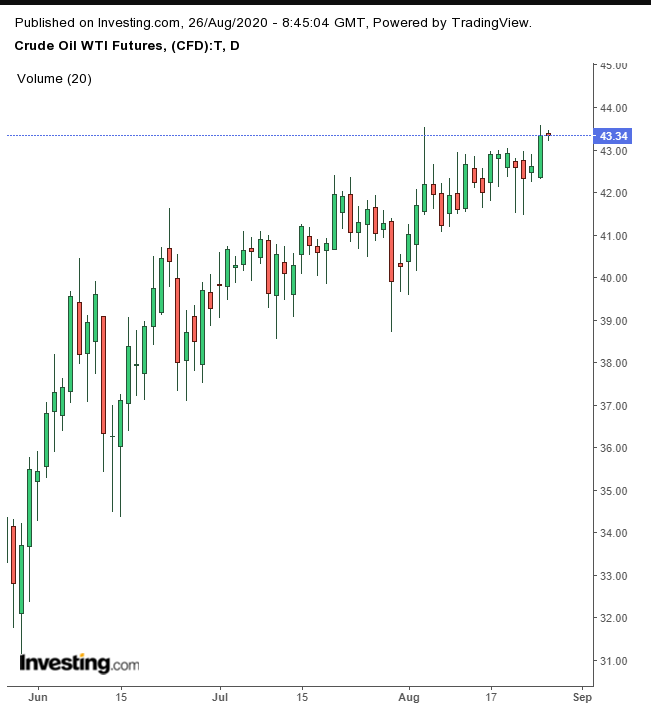- S&P 500 hits third consecutive record but futures waver
- Dow bucked the trend after biggest component reshuffling in seven years
- Oil touched five-month high
Key Events
US futures for the Dow Jones, S&P 500, NASDAQ and Russell 2000 were mixed on Wednesday, though European shares moved higher as investors tried to maneuver between the risk of profit-taking off record highs and expectations for looser monetary policy after tomorrow's Fed speech.
Treasuries and European bonds extended a decline. Gold traded within its recent range.
Global Financial Affairs
After news indicated that US-China relations have been thawing, at least until after the US election, the biggest story now is Fed Chairman Jerome Powell's virtual Jackson Hole speech, scheduled to be delivered on Thursday. The market expects the Fed Chair to upend a decades-long policy of capping inflation, instead of letting it rise going forward, with the hope this will spur growth.
The expectation is that allowing inflation to rise means interest rates will stay lower for the foreseeable future. Also, a weaker dollar makes the USD denominated American stocks cheaper. Both these factors are seen to be headwinds which will keep pushing this incredible Wall Street rally, which started from the March bottom.
That said, there's a thick cloud of uncertainty currently hovering: about how long COVID-19 will remain a critical factor; how bad it might it get; the progress of medical science and the logistics regarding the distribution of any vaccine to fight it; the rate and extent of unemployment triggered by the economic fallout of coronavirus; and whether the Democrats and Republicans will be able to reach a compromise on economic aid ahead of the US election in November.
All this provides a frame for Fed policy, however, US central bank can be only as effective as consumers and investors allow it to be. In other words, it is the sentiment elicited, meaning the reaction to the policy that drives the economy—not necessarily the policy itself.
With all that poised in the background, this morning, contracts on the S&P 500 crawled into positive territory, picking up from the underlying benchmark’s all-time high yesterday, before reversing lower at time of writing.
The Stoxx Europe 600 Index was marginally higher after swinging between gains and losses.
Yesterday, during the New York session, shares notched a third consecutive record high within a four-day spree, pricing in the possibility of additional accommodation by the country’s central bank. Facebook (NASDAQ:FB) led the rally, (+3.5%)—posting its own all-time high—after the social media giant launched a series of tools to expand shopping on its platforms. The move will probably siphon off customers from Amazon (NASDAQ:AMZN), which climbed less robustly, (+1.18%), while recording a new record close, though the stock failed to achieve a fresh all-time high.
The Dow Jones Industrial Average was the only US benchmark in the red, (-0.2%), after the biggest reshuffling of it 30 components in seven years, as technology stocks replace energy shares, to better represent the new economy.
Yields, including for the 10-year US benchmark, climbed for the third day, threatening to establish a short-term uptrend.

An uptrend in rates fosters a short-term downtrend for Treasuries—if yields top the Aug. 13, 0.727 level.
The dollar trimmed yesterday’s losses.

Technically, the greenback rebounded off the bottom of a Rising Flag, bearish after the five-day selloff that preceded it, which also completed a pennant, that was also a bearish pattern—both within a steepening falling channel.
Gold rebounded from a fourth-day selloff.

The yellow metal bounced off the hammer from Aug. 21, which confirmed Tuesday’s inverted hammer. And both reinforced the bottom of a rising channel. That uptrend since the March bottom is being challenged by a rising flag, bearish after the double-digit percent plunge that preceded it.
Bitcoin may have topped out.

The price of the cryptocurrency fell below its trend line since July 28, along with falling volume momentum and price average comparisons.
Crude oil temporarily traded near its highest level in five months.

WTI's rise came as Hurricane Laura bore down on key refining facilities on the US Gulf Coast.
Up Ahead
- The US Republican National Convention continues through Thursday.
- The Bank of Korea sets monetary policy and will hold a briefing on Thursday.
- Fed Chair Powell speaks on Thursday.
Market Moves
Stocks
- Futures on the S&P 500 Index was up 0.1% at 3446.62.
- The Stoxx Europe 600 Index gained 0.1%.
- Germany’s DAX rose 0.3%.
- The MSCI Asia Pacific Index increased 0.1%.
Currencies
- The Dollar Index climbed 0.1% to 93.11.
- The euro fell 0.1% to $1.1821.
- The Japanese yen strengthened 0.1% to 106.28 per dollar.
- The British pound was little changed at $1.3154.
Bonds
- The yield on 10-year Treasuries gained three basis points to 0.71%.
- Germany’s 10-year yield climbed two basis points to -0.42%.
- Britain’s 10-year yield increased two basis points to 0.28%.
Commodities
- West Texas Intermediate crude climbed 0.1% to $43.40 a barrel.
- Gold weakened 0.5% to $1,917.94 an ounce.
